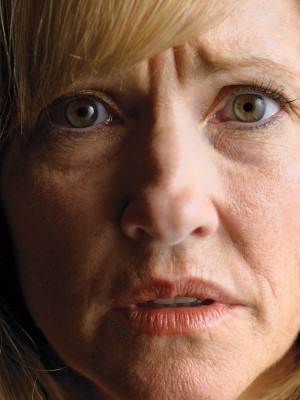 This article is long… the original writer was probably paid for each word… In spite of my intent to edit it, I could not make it shorter.
This article is long… the original writer was probably paid for each word… In spite of my intent to edit it, I could not make it shorter.
The gist of it is that instead of using our god given ability to think to think things through, to plan, to prevent, we use it instead to worry… Worry is unproductive and makes absolutely no difference. In fact, it makes you stupid… Very stupid, unprepared, make emotional decisions, avoid action… in simple terms, to become a Shrinking Human… instead of an Expanding Human Being.
Oh, and it also makes you sick… if being sick and stupid with worry weren’t enough.
Experts now argue that the worry epidemic can have devastating effects on work, health and children…
Worry. Never has a society worried about so much—and so little—simultaneously. We’re tied in Gordian knots of worry, every Twitter refresh delivering new fretting points. “Frost quakes” and polar vortex, the scary new term for winter, have been added to climate change fears. Last week’s news that PAHs (polycyclic aromatic hydrocarbons) caused cancer again foisted grilled and smoked meats onto the long list of foods that might one day kill us. Everybody has his or her own worry list, which might or might not contain H5NI, vaccine fear, bio-terrorism, your kid passing his finals, cyber-terrorism, those grey hairs, the grid going dark, drivers who text, stock market collapse, job loss, gluten, debt, that guy eying your job, your RSP, E. coli in packaged salad.
Worrying is endemic, 1 mental health professionals will tell you.
The term “worrying” has replaced “thinking,” says California-based clinical psychologist Daniel Peters. “People don’t say, ‘I’m thinking about this’ anymore; they say, ‘I’m worrying about this.’ ”
Like a virus, worry begets worry, literally.
Hovering “helicopter” parents’ new concern is that anxiety will impede their children’s academic performance, and success. “I’m spending more and more time talking to worried parents about their worried kids,” says Toronto psychologist Alex Russell.
Pressure on children to perform, combined with the modern parenting model, creates a Catch-22 worrying loop, he says. “Parents are explicitly and implicitly told to monitor, organize and direct their child’s life while worried that, if their children fail, it will reflect badly on them,” he says. “They do all the worrying about reality, so kids tend to fall behind in learning how to adapt to reality.”
“Worry,” a human habit, is now used interchangeably with the clinical diagnosis of “anxiety,” says Russell. He draws a line between fear and anxiety: “Fear is a basic animal brain response. You see something dangerous and you have the ‘flight or fight’ reflex. It’s in the moment, now.” Anxiety is like fear, only anticipatory—of something down the line that could be truly fearful, he says: “It’s fear plus planning; it’s your lizard brain, at the back of the brain, with the frontal lobes. It’s the forward planning that separates man from beast.”
Pressure to perform academically is creating a new generation of worriers, he says. “We confuse getting high marks with getting an education, and there’s standardized testing up the wazoo.”
It’s a familiar trope in entertainment: A recent episode of Modern Family showed Grade-A student Alex Dunphy discussing anxiety with her therapist: “I’m overwhelmed, but feeling I’m not doing enough at the same time.” Russell says psychologists are seeing a new disorder dubbed “school refusal” — children unwilling to go to class. It tends to afflict high-achievers in high school, though he has seen two elementary school students with the problem.
The identification of the COMT gene, known as the “worrier-warrior gene” and associated with how people cope under stress, has amped up concern.
“Parents come to me and ask, ‘Does she have anxiety?’ the same way they’d ask: ‘Does she have leukemia?’ ” says Russell. Eradicating the spreading “worry virus” has become a self-help sub-genre, with such titles as The Paranoid Parents’ Guide: Worry Less, Parent Better, and Raise a Resilient Child, and Why Worry? Stop Coping and Start Living.
Worrying is a time-waster, a self-destructive tendency. Peters calls it “a useless mulling over things we cannot change” that “drains energy and prevents us from taking risks.” His books instruct children to see worry as a bully, “the worry monster.” He is “committed to the vision of a worry-free world,” he writes, a claim he qualifies in an interview with Maclean’s: “I’m not talking about a Pollyanna-ish approach, where we don’t worry about the realities of the world; I’m talking about levels of anxiety and worry that limit kids and adults from living their lives—because they’re crippled by doubt and fear of things that will never come and likely will never come.”
Children aren’t the only ones being told worry is holding them back. Worriers and Warriors: The Survival of the Sexes, newly published by Oxford University Press, argues that women’s hard-wired tendency to fret is why they’re not making greater advances professionally.
“Anxiety is part of being a woman,” writes psychologist Joyce Benenson of Boston’s Emmanuel College (with Henry Markovits of the Université du Quebec). Women “are guided by genes to worry about their and their children’s survival, even when there is nothing serious to worry about,” she writes, noting women are diagnosed with much higher rates of specific forms of anxiety, or phobias, than men, and are twice as likely to be diagnosed with post-traumatic stress disorder. (“Negative life events, even minor ones, are more traumatic for females than for males of all ages,” she writes.) The point is illustrated, not with scientific data, but with a folksy Garrison Keillor story about a mother and father seeing their son off on the bus to overnight camp. The father enthusiastically shares his own camp adventures while the mother is silent, caught up in pointless worry: “Do the brakes work? Who is the driver? Is he licensed? Sober? Might he be carrying a pistol? Are the wheels securely fashioned to the hubs?”
 Benenson says because males are hardwired to “specialize in worrying about enemies,” she says, they worry far less “because the enemy is not always present.” But her book also suggests that men don’t worry partly because women do it for them: She invokes the cliché that men don’t remember children’s birthdays, but can recall random sports stats.
Benenson says because males are hardwired to “specialize in worrying about enemies,” she says, they worry far less “because the enemy is not always present.” But her book also suggests that men don’t worry partly because women do it for them: She invokes the cliché that men don’t remember children’s birthdays, but can recall random sports stats.
Worry hasn’t always been such a cause for concern. Research dating back over a century asserts that moderate levels of anxiety, that “adrenalin rush”, improves performance, and that too little worry can impair it. Psychologist Michel Dugas of Concordia University sees worry as a bell curve: Moderate levels improve functioning, while excess levels cause a decline in performance.
Worry’s new status as a pernicious virus in all forms has been paved by a confluence of forces, both medical and social. Research outlining the health risks of stress is mounting. And it’s communicated via a conduit blamed for increasing anxiety: the Internet, that transmitter of often contradictory information overload, “all of the scary things happening around the world on a moment-to-moment basis,” as Peters puts it. It’s a constant reminder of the challenges of modern life. At the top of the list: pressure on women to perform Cirque du Soleil-style work-family “balancing acts,” which now include remembering to “lean in” at the office.
But the vilification of worry, as framed in the “warrior-worrier” divide, also reflects a cultural moment, a shift from valuing prudence, thoughtfulness and sensitivity to others, once viewed as key to adaptation and survival. In their stead, there is a renewed veneration of the aggressive, Wolf of Wall Street, risk-taking personality able to thrive in a turbo-charged workplace, damn the consequences and the effects on co-workers. (Such thinking is also seen in the revival of the Myers-Briggs Type Indicator to assess employment candidates; the latest thinking suggests people who are “extroverted” and “judgmental” earn the most money.)
In the battlefield of life, goes the thinking, warriors are the winners, worriers the losers. “The idea of a worrier is one who is disempowered and scared,” says Peters, “where a warrior is one who is courageous and can take on obstacles.” It’s a dichotomy that leaves worrying women or men with “female” traits by the roadside.
Mankind has always sought remedy for worry. The ancient Greeks used “worry beads”; people living in a “don’t worry, be happy” culture take pills, hire therapists, practice “mindfulness” and read self-help books.
Tranquilizers, the “happy pills” embraced by Hollywood in the 1950s, in fact, preceded anxiety’s classification as a mental illness in 1980. “Generalized anxiety disorder” (GAD) was introduced in the third edition of the Diagnostic and Statistical Manual of Mental Disorders, psychiatry’s Bible. GAD, characterized by a medley of symptoms, primarily “chronic worry,” is currently the most commonly diagnosed mental illness; more than 40 million North Americans suffer from it.
Worry joined the spectrum of anxiety-related pathologies. Psychologist Thomas Borkovec of Pennsylvania State University found worry had three components:
- overthinking,
- avoidance of negative outcomes and
- inhibition of emotions.
By 1990, he’d helped develop the “Penn State Worry Questionnaire,” a diagnostic tool that led researchers to include worrying as part of all anxiety disorders. 2
That line has gotten more blurry given rising concern over the health risks of stress, a medical preoccupation with the physical effects of stress 3
 The isolation of the COMT gene, originally called the “Woody Allen” gene by Harvard researchers, confirmed belief that worrying was a genetic condition: COMT carries the code for an enzyme that clears the neurotransmitter dopamine from the prefrontal cortex 4
The isolation of the COMT gene, originally called the “Woody Allen” gene by Harvard researchers, confirmed belief that worrying was a genetic condition: COMT carries the code for an enzyme that clears the neurotransmitter dopamine from the prefrontal cortex 4
By 2013, the pathologizing of the worrier with the clinical condition of anxiety was entrenched, evident in a survey by the Centers for Disease Control and Prevention that asked people whether they felt “worried, nervous or anxious” on a daily or weekly basis: 22 per cent of women and 16 per cent of men reported that they did.
The fact that more women than men responded in the affirmative could reflect the fact that women are cultivated; they are routinely targeted with constantly shifting fear-mongering, whether it’s used to sell women’s magazines, hand sanitizers, child car seats, bottled water, moisturizer or nutritional supplements. 5
Stoking anxiety is an effective selling tool, says Peters: “It’s the No. 1 way to increase ratings or to sell products.” Corporations aren’t alone in doing this. Institutions and special interest groups also fuel worry, 6 For more than a century, North Americans have fallen prey to “fears that have had the backing of the nation’s most eminent scientific, medical, and governmental authorities that turned out to be either groundless or at best unduly exaggerated,” writes Levenstein, 7
Given the spotlight on worry, it’s little surprise that Scott Stossel’s new memoir, My Age of Anxiety: Fear, Hope, Dread, and the Search for Piece of Mind, has hit a nerve. Stossel, editor of The Atlantic, delves into the history of anxiety while examining his own life as “a twitchy bundle of fears, anxieties and neurosis.” (A short list of his phobias: heights, enclosed spaces, flying, public speaking, cheese, vomiting.) An arsenal of treatments—prescription drugs, therapies, self-medication (scotch, vodka)—failed to provide a cure or sustained relief for his anxiety, the source of which is unknown.
Yet Stossel’s panic attacks and tendency to “catastrophize” events by jumping to the worst-case scenario have not precluded professional success, a point that also can be made about other famous “neurotics” including Woody Allen and David Sedaris. In fact, one could argue that Stossel’s anxious and obsessive tendencies yielded a book that’s meticulously researched, complex and nuanced—and a New York Times bestseller.
Wading through the reams of increasingly contradictory research about worry suggests its vilification is seeded with cultural biases, particularly regarding women. Warriors and Worriers, for example, lays women’s failure to advance in the workplace squarely on their tendency to fret, overanalyze and compete with one another. Yet a study conducted at the University of Wales in 2005 (“Can worriers be winners?”) found smart people who worry actually produce the best results and that financial managers high in anxiety tended to be the most effective money managers, provided they also have high IQs. It concluded: “Anxiety is an important component of motivated cognition, essential for efficient functioning in situations that require caution, self-discipline and the general anticipation of threat.” Research out of UCLA last year, published in the Academy of Management Journal, found “neurotic” personalities actually shine in team settings over time versus more “extroverted” employees. One explanation: they were anxious to please the team. In conversation, Benenson herself acknowledges women’s tendency to worry makes them better long-term planners than men, who tend to solve narrow problems that are easily tackled.
Russell intimates that attitudes to anxiety are culturally ingrained when he speaks of a “girl solution” and “boy solution” to anxiety, with the proviso that deviations occur. Girls tend to “play the system,” he says: “They’re wonderful gold-star earners; pleasers and appeasers, which can lead to further anxiety disorders.” Boys, on the other hand, want to jump off “this conveyer belt of life,” as one of his male patients put it: “They head to the basement and the bong and Call of Duty and anything that reduces anxiety to the absolute minimum.”
But Peters, for one, doesn’t believe anxiety is sex-specific: “Boys and girls, men and women are scared and anxious.” He sees at least as many anxious boys as girls, noting that could be linked to the fact his practice specializes in bright and “gifted” individuals: “We see more sensitive boys than the general population.” Gifted children are more susceptible to anxiety and worry, he says: “They experience extra sensitivity to their own experience, increased sensitivity to others as well as advanced thinking about the world before they have the life experience to make sense of it.”
Peters claims basic behavioral modification techniques, like keeping a “worry diary,” can transform a child overburdened with worry. “They’re scared, they’re avoiding,” he says. “Then you see their body language change; they talk about victories and their confidence grows.”
We’re learning that framing worry as a negative can in fact undermine its benefits. Research conducted by psychologist Jeremy Jamieson of the University of Rochester, cited in Top Dog: The Science of Winning and Losing by Po Bronson and Ashley Merriman, found students who were told not to be “concerned” about stress and to think of it as a performance aid did better when tested and improved their grades more than those not given the instruction.
As we learn more about worry, we’re finding the worrier-warrior divide itself might be misplaced. The OptiBrain Center, a U.S.-based consortium of cognitive neuroscientists, found some Navy SEALs have “worrier genes,” as do one-third of expert pilots—a larger proportion than in the population. Again biases may be at play: the meticulous forward-planning required to execute the capture of Osama bin Laden, for example, is not “worrying” but “strategizing.” (The CIA analyst who spent years tracking down bin Laden was a woman.)
Worry is intractably linked to intelligence, to what it is to be human, the psychologist Howard Liddell wrote in 1949: “I have come to believe that anxiety accompanies intellectual activity as its shadow and that the more we know of the nature of anxiety, the more we will know of intellect.”
The mounting stigmatization of worry, or “obsessive thinking,” “thought addiction” and “intrusive cognitive activity” as it is referred to in scientific literature and by the worry industry, concerns Frances. “Worry is an absolutely essential part of the human condition,” he says. “We worry because it is adaptive to worry: people unable to worry fail to see future dangers, get into all sorts of trouble, and haven’t done very well in the struggle for survival.” The prospect of man waging war on worry is absurd, like man waging war on himself, he says: “The history of psychiatry is filled with dumb fads and this sounds like the possible beginning of one.”
- Endemic means, here, that it is ever present, that you don’t need an external stimulus to bring it on, you are naturally worried, without cause…
en·dem·ic
en?demik/
adjective
adjective: endemic1.
(of a disease or condition) regularly found among particular people or in a certain area.
“areas where malaria is endemic”
denoting an area in which a particular disease is regularly found.
2.
(of a plant or animal) native or restricted to a certain country or area.
“a marsupial endemic to northeastern Australia”noun
noun: endemic; plural noun: endemics - The DSM-III was revised in 1987 to include “chronic worry” as a mental health problem and identify it as the primary feature of GAD. Many mental health professionals regard the arbitrary definition of GAD as a problem, among them psychiatrist Allan Frances, author of Saving Normal: An Insider’s Revolt Against Out-of-Control Psychiatric Diagnosis, DSM-5, Big Pharma, and the Medicalization of Ordinary Life: “There is no clear line separating normal worry from a mental disorder,” Frances says in a email. A GAD diagnosis, he says, should be “reserved for the very few who have persistent, severe and incapacitating worries, not for the average person for whom worrying is just part of life.”
- dating to the work of Hans Selye in the 1920s; the Hungarian-Canadian endocrinologist pioneered research into the “stress response” and was the first to demonstrate the existence of biological stress. Research confirming the risks was given big media play. A 2006 meta-study conducted by researchers at Columbia University, the National Institute on Aging and Leiden University in the Netherlands, for instance, found “over-worrying” taxes the body and promotes cardiovascular problems; it also found prolonged periods of stress weakened participants’ endocrine and immune function, making chronic worriers more susceptible to disease. Yet research highlighting the benefits of stress tend to be ignored, like the study out of Duke University last year that suggests repeated, manageable stressors in childhood—a brief daily separation from mother, say—can make people more resilient later in life.
- the part of the brain responsible for advanced decisions, resolving conflicts and anticipating future consequences, allowing it to work at optimal function. The gene comes in two variants—one builds enzymes that removes dopamine slowly, the other rapidly. The duality prompted David Goldman, chief of human neurogenetics at the U.S. National Institute of Health, to label it the “worrier-warrior” gene. The slow-acting “worrier” variant, estimated to be present in 25 per cent of the population, is associated with problem-solving, orchestrating complex thoughts and long-term planning. “Worriers” perform well on cognitive tasks requiring memory and attention; they also excel at avoiding danger. People with the faster-acting “warrior” variant, another 25 per cent of the population, function most efficiently under stress: they find focus faster, are less anxious and susceptible to pain. (The remaining 50 per cent fall between the two extremes.)
- A sampling of current magazine covers reveals a gender divide. Women’s magazines stoke worry and avoidance (Allure: “Diet shocker! Foods that make you look older;” Prevention: “10 best fish to buy, 10 to avoid”), while men’s magazines focus on action (Outside: The gold medal diet: What Team USA eats to win”).
- as historian Harvey Levenstein demonstrates in his 2012 book, Fear of Food: A History of Why We Worry About What We Eat.
- a professor emeritus at McMaster University. Identifying—and overstating—food dangers is how public health agencies, nutritionists, disease charities and scientists remain relevant, he writes. And their primary target remains women, sole guardians of children and health and home, even into the 21st-century, if marketers are to believed.
